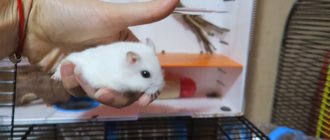Home » Hamsters » A hamster’s eye does not open and is festering - what to do
Hamsters have good health and rarely make their owners worry about their pet's poor health. However, such animals also get sick. Sometimes owners experience that their eyes stick together. The article will tell you why this happens and how you can help if the hamster’s eyes do not open.
Bulging eyes
This is more likely not a disease, but a consequence of injury to the eyeball, which has a bad effect on the general condition of the animal. A hamster can damage its eyes both in the fight against other rodents for survival and from dangerous objects contained in the cage - wood chips, sawdust, wire, etc.
As a result of injury, the invading pathogenic bacteria begins to rapidly multiply, penetrating even under the eyeball itself. Such a pet will most likely face surgery to remove the damaged organ. Otherwise, the bacterial infection can develop further, affecting the entire body. Then the rodent can no longer be saved.
We suggest you read: Why the gosling does not eat medicine for goslings
What eye diseases do hamsters suffer from?
Of course, there are real eye diseases that affect rodents. These are not allergic reactions, not manifestations of any internal pathologies, not the consequences of injury and not a sign of age-related changes, but ordinary ailments of the organs of vision that require diagnosis and special local therapy.
Hamsters suffer from the following eye diseases:
- conjunctivitis;
- blepharitis;
- “bulging eye” symptom.
In fact, the symptom of a “bulging eye” is not a disease; this pathology is a consequence of advanced conjunctivitis or serious injury. However, since this condition requires serious treatment, veterinarians classify it as an eye disease, although they call it a symptom.
Treatment for droopy eyes
If an animal's eyes are stuck together, you should not try to forcefully separate the eyelids - this will lead to injury. In this case, rinsing is carried out, but the crusts are generously moistened with a medicinal agent. After this, they soften and become easier to remove.
To eliminate eye stickiness, you should clean your eyelids with saline solution.
Why is conjunctivitis dangerous?
Conjunctivitis for hamsters is not at all the same as for humans. If a person can cope with this problem in a few days with the help of eye drops, then your pet does not have the opportunity to overcome the disease on its own. For this reason, you need to be wary if you notice at least one of the signs of conjunctivitis. It is worth considering that conjunctivitis, as a rule, is the very beginning of the pathology. Without taking appropriate measures, conjunctivitis will quickly turn into keratitis, followed by ulceration of the cornea of the eye. If a hamster's eye is swollen, but the owner does not pay any attention to it for a long time, then the rodent may go blind and then die.
The same dangers await the pets of their owners, who not only do not pay attention to the problem, but treat the pet incorrectly.
Under no circumstances should you self-prescribe pills to your pet or, even worse, give injections. This should only be done by an experienced veterinarian.
If you prevent your hamster from getting sick or detect it in time, you won’t have to think about why your hamster’s eye popped out and how to help him in such a situation. Often, due to late detection of the disease, pets completely lose their vision.
Belmo
A separate case, although not uncommon, is when a hamster has a white spot on its eye. Veterinarians call this pathology a thorn. The main reason that a hamster's eye turns white is trauma, in some cases cataracts.
It also happens that a hamster has a white spot on his eye that completely covers the entire eye. Homkin's white eyes need to be examined by a veterinarian to determine whether it is an injury or indeed a cataract. But neither one nor the other is an infectious disease, so it cannot be treated with any drops or ointments. Your pet will continue to live, but with the resulting defect.
How to handle an animal that has lost an eye
If your hamster's eye has leaked or fallen out, the first thing you should do is visit a clinic. There, the damaged tissue will be treated to prevent infection. In the future, they try not to expose the animal to stress; if possible, they refuse to walk or ensure safety with the help of a soft sphere. For hamsters, hearing and smell are more important, so they adapt quickly.
Sources:
https://kotsobaka.com/gryzuny/chto-to-s-glazom.html https:///homyaki/chto-delat-esli-u-homyaka-sliplis-glazki.html https:///lechenie/bolezni- glaz-u-khomyakov
Blepharitis
This disease may be a consequence of advanced conjunctivitis. In this case, the inflamed eyelid sticks together, and the inflammatory process spreads deeper and deeper inside. At an advanced stage, both organs of vision may be closed. This disease is accompanied by redness and swelling of the eyelids.
What to do in this case? This disease can be treated if you consult a veterinarian in time. Often the treatment regimen is identical to the treatment regimen for conjunctivitis. Often, special eye drops are used in the treatment of this disease, for example Tsiprovet or Floxal, as well as additionally tetracycline ointment.
With this disease, the hamster should be put on a diet and the cage should be disinfected.
In what cases should you contact a veterinarian?
Sometimes trying to help a pet on your own is the worst idea, since unnecessary delay can lead to very sad consequences. Here are the cases in which you need to contact a veterinarian immediately:
- The animal feels so bad that it eats poorly or refuses food altogether. If your pet refuses water, you should call a doctor immediately, regardless of the time of day.
- Severe weakness and apathy. For normally active hamsters, these signs are atypical and strongly indicate serious health problems.
Providing first aid to a sick hamster
Timely provision of first aid to a sick animal is extremely important:
- The pet is given complete rest and is not disturbed unless unnecessary.
- In some cases, it is possible to remove foreign objects and debris from the animal’s eyes. To do this, experienced breeders use a small syringe and warm saline solution.
- If an allergy is suspected, your pet can be given a couple of drops of Zyrtec or a similar drug. Diphenhydramine and other medications in tablet form should not be given, as dosing problems may arise.
Other causes of eye sticking in hamsters
Let's look at other causes of eye sticking in hamsters:
- Ophthalmological pathologies in pets with fluffy, long hair. It happens that it either gets into the eyes, or begins to grow so that the hairs rest directly on the surface of the cornea. For this reason, such pets should regularly trim the overgrown fur around their eyes.
- If grass from the nearest roadside is used to feed the animal , the “homa” may get stubble in the eye (these pets are not particularly brilliant, unfortunately).
- If the animal regularly runs around the house in free-range mode, then even more troubles can happen to its eyes. A pet can injure its vision organs with small elements of children's toys and various household garbage. In addition, in this case, household chemicals may get into the animal’s eyes, which will almost certainly lead to the hamster’s blindness.
Prevention
Knowing that rodents are predisposed to eye infections, you need to take care of prevention:
- once a year examination by a ratologist;
- cleaning the cage and room with the addition of disinfectants once a month;
- creating a healthy diet;
- adding vitamin complexes;
- daily change of water and cleaning of drinkers and feeders.
It is important to limit the animal’s free movement around the house. It is necessary to prohibit children from feeding their pets with prohibited foods. After direct contact with an animal, you should wash your hands with soap. Under such conditions, the owner will be able to ensure the health of the animal for a long time.
Oral and dental diseases
Hamsters, like any rodents, grow their incisors throughout their lives, so owners should pay special attention to oral hygiene and the animals' teeth. If the pet does not grind down its teeth, this will lead to injury, damage to the oral mucosa, the development of acute inflammation, the formation of abscesses, and abscesses.
Pathologies and dental diseases in Djungarians and Syrians are manifested by redness of the mucous membranes, hypersalivation, decreased appetite, weight loss, abnormal growth, deformation of the incisors, and inflammation of the cheek pouches.
Inflammation of the cheek pouches is one of the most commonly diagnosed pathologies. It is characterized by inflammation, prolapse (prolapse), and the appearance of pathological formations.
The disease develops due to injury to the oral mucosa. With this pathology, the animals behave restlessly, rubbing their cheeks and muzzle with their paws.
Appetite decreases. Saliva flows from the mouth.
As a rule, the pathological process affects the inner surface of the cheeks.
To relieve inflammation, you need to rinse your pet’s mouth with an antiseptic solution or chamomile decoction. To normalize digestion, give your hamster probiotics and enzymes.
For neoplasms, surgical treatment, restorative, and symptomatic medications are prescribed.
If your hamster has inflamed cheek pouches, treatment should be carried out by a veterinarian. The specialist will carefully turn out the cheeks and clean them of food debris. Inflammation will be relieved by bactericidal drugs, antiseptics, and medications for local and general treatment. After therapy, the hamster must be kept on a fasting diet for 12–14 hours.
Tumors and neoplasms
Tumors (malignant, benign), pathological growths on the body, legs. ears is a fairly commonly diagnosed pathology in rodents, which can develop for a variety of reasons. Bumps can appear due to injuries, severe bruises, or falls from a height. To begin treatment, you need to establish a diagnosis, so take your pet to a veterinarian.
For benign and malignant tumors, surgical treatment will be prescribed. If the cancer is localized in a hard-to-reach area (oral cavity), or the tumor has metastasized, veterinarians recommend euthanizing the hamster, since no treatment method will give the desired result.
Well, the most serious category of diseases are tumors and neoplasms, which are very common in hamsters. And, it may not necessarily be cancer, as many rodent owners think, but also the consequence of an unfortunate lump as a result of a bruised limb. But, in order for all your doubts to be dispelled and the rodent to be correctly diagnosed, contact a specialist.
Eye diseases associated with aging changes in the body
Very often, with age, hamsters develop such an unpleasant disease as cataracts. It manifests itself as white spots, clouding of the lens, and blurred vision. The animal gets really stressed because it begins to see poorly. Unfortunately, this disease can rarely be cured; all that remains is to make the animal’s life as easy as possible by following certain tips:
- Do not place the hamster's cage in direct sunlight, this will further irritate the eyes and worsen the situation;
- Don't give your animal a lot of sweets. In return, give a lot of carrots and zucchini.
- Do not place many objects in the cage, because due to poor eyesight the animal may hit them and injure itself.
This is all you can do for your pet to somehow make his life easier.
Preventive measures
Agree, it is better to prevent any disease in domestic hamsters than to treat it later. And for this you need to create the necessary conditions for your pet. Considering the causes of such diseases, caring owners should:
- Use cage mats specifically designed for hamsters. Such material should not contain piercing or cutting objects, as well as a lot of dust.
- You should not keep a large number of rodents in one cage. They can injure each other, which will result in various diseases, including eye diseases.
- Genetically predisposed individuals must be immediately excluded from the general “herd.” Such hamsters can be a carrier of an infection from birth, transmitted to them from their mother or father.
- During the keeping process, the cage with rodents must be placed in a bright place, but protected from the sun. Direct exposure to sunlight and ultraviolet radiation negatively affects the health of pets.
- Regular examination of animals will help you at an early stage to identify not only carriers of diseases, but also to prevent the development of an already established disease in hamsters.
A hamster's eye does not open, turns sour or festeres: what to do
Before taking measures to treat your pet, you should show it to a veterinarian, because self-treatment can only worsen the situation. But before you go to the doctor, you should do the following:
- If the hamster does not live alone in a cage, it must be isolated from other animals so that they do not get sick if it is a virus;
- The rodent's cage and all accessories must be disinfected. A solution of potassium permanganate or soda solution is suitable for this;
- The cage with the sick hamster should be removed away from bright light, so as not to further irritate the animal’s mucous membrane;
- Be sure to ensure that your pet always has access to fresh water.
Does it happen that your hamster behaves aggressively for no reason?
What to do if a rodent's eye turns sour or festeres
Festering of a pet's eyes can occur due to harmful microorganisms entering the mucous membrane, which give rise to various diseases, for example, conjunctivitis. In this case, you need to rinse the eye mucosa with warm saline or an aqueous solution of furatsilin. Use a cotton pad for this.
If furatsilin does not help, you should resort to a stronger remedy. For example, to drops with a broad-spectrum antibiotic (Floxal or Tobrex). They should be used according to the following scheme: 1 drop in each eye 4-6 times a day, for 5 days.
IMPORTANT! The antibiotic is a fairly strong drug, so it is used only as a last resort and on the recommendation of a veterinarian.
If the rodent's eyes do not open
There can be many reasons for a non-opening eyelid. In any case, it would not be superfluous to use special Albucid drops . Before each use of the medicine, it is necessary to wipe the inflamed eye with warm saline solution to remove accumulated pus and other secretions.
To do this, soak a cotton pad or cotton swab in the solution and very carefully wipe the animal’s eye. Albucid should be dripped every day 1-2 times until the animal is completely cured. At the same time, do not forget that the hamster should still be shown to a doctor, even if the eye returns to normal in just a couple of days.
IMPORTANT! When trying to remove discharge from the eye, do not rub the mucous membrane too much, otherwise this may lead to additional eye irritation.
Redness
If one or even both eyes of a hamster are red, and no discharge, including purulent discharge, is observed, at first you can help the animal yourself. At home, a weak saline solution is prepared for this from warm boiled water and table salt, which will act as an antiseptic and eliminate any pathogenic microflora formed on the mucous membrane of the eyes. The ratio of salt and water should be 1 to 5. Wipe the hamster's eyes with the prepared solution several times a day. A cotton pad or gauze folded several times is suitable for this.
In addition to the saline solution, a weak infusion of chamomile or a brew based on black tea is suitable. You need to wash your hamster’s inflamed eyes with these products at least three times a day.
There are many reasons for this reaction
Main reasons
Rodents are often susceptible to infectious and age-related eye diseases. If it is difficult for a hamster to open its eyes, it is imperative to figure out the cause of the problem, otherwise irreversible consequences will begin.
Allergy
Tearfulness can occur due to the consumption of exotic fruits and other unusual delicacies. Also the cause is the detergents used when processing cells, as they contain a large number of chemical compounds.
Unsanitary conditions
One of the common causes of eye diseases in rodents. Over time, microbes begin to multiply in the litter and bedding. And hamsters often sit and hide in them from people, so it is important to periodically change them.
Trauma and injury to the cornea
Hamsters can easily injure themselves. They can prick themselves on sharp oat straws, or a small particle of filler can penetrate under the eyelids. Inflammation of the cheek is also a factor in the onset of the disease. If several rodents live together in a cage, they can be injured during a fight.
With a fresh wound, the hamster squints due to the tearing of the eye. The affected area hurts, the pet is nervous, moves little and constantly hides. If the cornea is injured, microbes may enter and the eye may become sour.
Before the examination, it is necessary to clean the eyelids. When rinsing, do not use hydrogen peroxide or other liquids that harm the mucous membrane. If your eyes are stuck together, you need to soak your eyelids; under no circumstances try to force them open.
The easiest way is to soak it with a cotton swab dipped in boiled water. You cannot use regular cotton wool, as its fibers can remain on the eyelids or eyelashes and cause re-infection.
It happens that the eyelid is injured, in which case you need to lubricate it with tetracycline ointment twice a day.
Weak immunity
Eye ailments in hamsters can be in addition to tuberculosis, pneumonia and viral infections of the respiratory tract.
What else can cause hamsters' eyes to stick together?
The cause of inflammation and sticking of the eyes in such animals can be the long hair that some types of hamsters have. Some hairs from the animal's face can get into the cornea of the eye, causing inflammation. To avoid this, you need to regularly trim the animal's fur around the eyes.
Inflammation of the eyes can occur due to the fact that the owner feeds it with grass from the street growing next to the road. Hard stubble can cause injury to the animal's eyes.
Free-roaming of an animal, in which it runs around the house, can also lead to eye injury from small objects, household chemicals, or small debris. Owners should not allow the animal to move freely around the house, as it may simply die if it gets into a place where its owners cannot find it for a long time.
Eye pseudo-diseases
Monitor your hamster's immunity
Often the cause of eye inflammation in a domestic hamster can be another disease. This phenomenon is possible if the rodent’s cheek pouches become inflamed. As a result, the animal's eye hurts, waters, and the lower eyelid swells. After some time, the eye can be observed to stick together and increase in size.
In such a situation, you need to do the following - seek help from a veterinarian. There is such a procedure as cleaning the cheeks. It will not only ease your pet’s suffering, but also relieve such consequences as redness, swelling, inflammation and suppuration of the eyes.
Non-inflammatory diseases
Non-inflammatory diseases include cataracts, cataracts, glaucoma and oncological pathologies. Some of them are related to genetics or age-related changes. In general, such pathologies progress more slowly, making it more difficult for owners to notice the symptoms.
Belmo
A cataract is characterized by the appearance of a white spot on the surface of the eye. The cause of the disease is trauma, and less commonly, cataracts. With massive damage, the stain can cover the entire surface. If some of the mucous membranes turn white, you need to contact a veterinarian. This will help distinguish the eyesore from other pathologies. The disease has no cure, but does not threaten the life of the hamster. The animal's vision may deteriorate.
An eyesore is caused by injury or cataracts.
Cataract
Cataracts in a hamster develop due to a metabolic failure in the lens. If the disease progresses, it leads to blindness. It is assumed that the pathology develops due to injuries, old age, frequent stress, etc.
Cataracts in rodents cannot be treated. Surgical intervention is not used for pathology, and eye drops are ineffective. The disease is easier to prevent than to cure. To do this, the pet is fed plant foods rich in retinol, is not given sweets, vision pathologies are promptly eliminated, and the cage is not placed in the sun.
Glaucoma
Glaucoma is characterized by increased eye pressure. Because of it, the tissues increase in size and begin to bulge. The pet is in pain. Without help, the eyes fall out or leak. The only thing a veterinarian can do in this case is to perform enucleation. The animal will lose vision, but the procedure will prevent infection and relieve pain.
Glaucoma causes increased intraocular pressure and is accompanied by bulging of the eyeballs.
Oncological diseases
A lump in the eye area may not be blepharitis, but a malignant tumor. There is no generally accepted effective treatment in this case, but you can try to save your pet. To do this, they turn to a ratologist to remove the tumor, after the operation they use antibiotics, drugs to strengthen the immune system and vitamins. Even if the treatment does not save the animal, it will improve its condition.
Injuries and inflammatory processes and their symptoms
In inflammatory processes associated with pathologies or injuries, the following symptoms occur:
- edema;
- inability to open eyes, squinting, trembling eyelids;
- liquid or purulent discharge, tearing;
- formation of a cone or barley;
- redness of the damaged area;
- hair loss on the eyelids and around the eyes.
The presence of these manifestations indicates infectious or age-related pathologies, and sometimes mechanical damage. In the latter case, infection with pathogens may occur later if the animal was not treated in time or the pet’s immune system is weakened.
When infected, the general condition further worsens. The pet refuses water and food, vomits, and digestion of food is disrupted.
Corneal damage
Damage to the cornea occurs more often in mobile, active animals. In most cases, the condition is associated with mechanical trauma.
Corneal damage often occurs due to mechanical trauma.
Shards, dust, sand, filler, etc. can get into your eyes. Sometimes the damage is caused by a scratch. In rare cases, the integrity of the cornea is compromised due to infectious pathologies, contact with chemicals and congenital pathologies.
If the pet's cornea is damaged, visual acuity decreases. The problematic eye is closed or squinted, the eyelids tremble. Sensitivity to irritants is increased: the pet hides in a bright room and suffers from severe lacrimation. The general well-being of the animal worsens. The mucous membranes turn red.
If damage to the cornea is associated with a foreign object, there is a chance that the latter will be removed without third-party intervention along with the discharge. Otherwise, you need to visit a veterinarian. After removing foreign bodies, the eyelids are washed with antibacterial agents and anti-inflammatory drugs are used.
Blepharitis
Blepharitis is an inflammatory process that primarily affects the eyelid rather than the eye. However, these are neighboring tissues, so as the disease develops, the organs of vision also suffer. Blepharitis develops due to many reasons. For example, due to bacterial infections, incorrect use of medications, inflammatory dermatological pathologies, gastrointestinal problems, etc.
Blepharitis is accompanied by purulent inflammation of the eyelids.
Blepharitis is characterized by changes in the color of the eyelids. They may darken, but more often they turn red due to inflammation. Sometimes the skin on them peels off. The animal suffers from itching. It scratches your eyes and can damage them. Another problem is weakening of local immunity and possible infection. Bumps often form on inflamed eyelids.
Blepharitis of the eye is usually treated with antibiotics. Additionally, it is important to maintain cleanliness in the cage and provide your pet with time. This will prevent the progression of the disease and infection of the tissues.
Abscess
Another name for an abscess is stye. This is not an independent disease, but a symptom. It can occur against the background of blepharitis, weakened immunity with concomitant infection, etc. When an abscess appears, the appearance of the eye changes, and a difference in size becomes visible due to the tumor. The temperature of neighboring tissues rises as a result of inflammation.
With an abscess, itching occurs, and sometimes mucous discharge appears. In rare cases, barley goes away on its own, but more often it requires veterinary intervention. Recovery occurs after the capsule is freed from pus.
Blunt trauma
A rodent can receive blunt trauma as a result of a fall. Sometimes an animal is accidentally crushed while walking. As a result, massive damage to all structures of the visual organs occurs. It is accompanied by severe hemorrhage. In case of injury, only 1 eye or both may be affected. A few hours after the injury occurs, the blood settles and the tissues turn red. The entry of blood particles into the vitreous body causes vision loss.
In case of injury, damage to one eye is typical.
If a blunt injury occurs, the animal should be taken to a veterinarian as quickly as possible. It is impossible to make a prognosis and cure your pet at home on your own. You can only provide first aid if you cannot visit the clinic in the near future. Apply a cool cloth soaked in saline solution to the damaged area and use antibacterial ointment. The latter prevents the cornea from drying out in case of severe swelling, if the animal cannot blink.
Conjunctivitis
Conjunctivitis is the most common eye disease found in hamsters. The pathology is characterized by bilateral inflammation, although this is an optional sign. The disease develops due to mechanical trauma, irritation from chemicals, infections, allergies, etc. The animal can become ill when in contact with household products, such as floor cleaning solution or hairspray. Filler, dust or sand can provoke inflammation. Poor quality litter injures mucous membranes.
With conjunctivitis, the animal's eyes begin to water.
Symptoms help indirectly determine the cause. In the initial stages, if the disease is caused by mechanical irritation or allergies, the discharge from the eyes will be clear. If there is an infection, the liquid becomes cloudy and later acquires a yellow or greenish tint. The animal can become infected with pathogens during the process if it is not given timely assistance.
Other symptoms include itching, pain, photophobia and watery eyes. The eyeball enlarges, the eyelids swell. To eliminate symptoms, anti-inflammatory and antibacterial agents are used.
Bacterial infections
Bacterial infection can be either an independent or concomitant disease. Most often, conjunctivitis develops as a result of the penetration of pathogens. An animal can become infected if it has a weakened immune system, is injured, has a damaged cornea, etc.
Bacteria multiply quickly, especially if the damage is deep. Without help, pathogens increasingly penetrate tissues. Subsequently, the bacteria, along with the bloodstream, are spread to all organs and systems, which can lead to the death of the animal. In case of deep infection, it is necessary to resort to surgical intervention, including removal of the eye, in order to save the hamster’s life.
How to treat inflammatory eye diseases
In case of inflammatory diseases, they try to provide rest to the animal. Rinsing is carried out to prevent eyelid sticking, infection and increased discomfort. If the eye is already infected with pathogens, the procedure prevents bacteria from further penetrating into the deeper tissues.
The filler must be removed from the cage. It is replaced with paper towels. All accessories are disinfected with hot water and soap. The cage is placed in a dark place.
Choice of medications
The choice of medications depends on the nature of the pathology. Anti-inflammatory drugs are most often used. The most neutral drug is saline solution. It is used to wash and moisturize the eyes. It does not cause tissue drying, and therefore does not contribute to further infection.
In most cases, antibiotics are included in the treatment regimen, even if there are no signs of bacterial infection. This prevents infection due to weakened immunity.
Preference is given to local drugs, since generic ones are ineffective.
If necessary, the discharge is removed with a soft sterile swab soaked in saline solution. For infection, use Furacilin. If there is no improvement within 2-3 days, use Tobrex or Floxal drops. If necessary, take a long break between washes and add ointment.
Drops for the treatment of inflammatory eye diseases in hamsters.
Cleaning your eyes at home
The eyes are washed with saline solution, weak tea leaves, chamomile infusion or Furacilin. To do this, take a soft swab or cotton swab, moisten it in the product and carefully move it from the corner of the eye towards the outside. You can't go against the grain when eliminating discharge. This will cause dirt to get into deep tissues. Do not press on the skin. This traumatizes the pet. A separate swab is used for each eye.
Diet restrictions
The menu during illness is strictly limited. The pet is fed mainly grain crops, and animal proteins are given in small portions. Diet diversity is avoided due to weakened immunity and the need to reduce the load on the gastrointestinal tract.
Diagnosis of disease and inflammation
The appearance of pus is explained by leukocytes fighting pathogenic microorganisms.
The presence of the disease can be recognized by the following symptoms:
- increased tearfulness;
- cloudy discharge from the eyes of various shades (white, gray, green, yellow);
- change in the size of the eyeballs;
- sticking of the eyelids and the inability to open them;
- decreased activity;
- refusal of food and water;
- avoiding bright light;
- redness and swelling of the eyelids;
- soreness of the affected organ;
- itching and hair loss.
To diagnose at home, use saline solution or boiled water at room temperature to soak dried pus. After cleansing, carefully examine your eyelids for injuries, styes, cataracts and other alarming symptoms.
In addition to injury, a local abscess known as a stye may occur on the eyelids.
When cleansing your eyelids, avoid using cotton wool, which can cause injury due to lint. Cotton pads are considered completely safe.
Do not use 1 disc on 2 eyes. In this case, the infection will spread.
Other diseases of hamsters
Hamsters are susceptible to cardiovascular pathologies, which can be congenital or acquired. Among Syrians and Djungarians, problems are detected in the functioning of the excretory system (cystitis, pyelonephritis), nervous disorders (encephalitis), which develop against the background of severe stress, due to overheating.
It is worth noting that severe fright can provoke paralysis and cause cardiac arrest, which will lead to the death of the hamster.
In any case, if you notice that your pet’s behavior has changed, your pet has become lethargic and inactive, do not ignore the problem. Many hamster diseases can be cured in the early stages of development.
Therefore, be sure to show your pet to a doctor or call a veterinarian at home. However, remember that many diseases and pathologies that occur in hamsters are easier to prevent thanks to proper care and maintenance.











